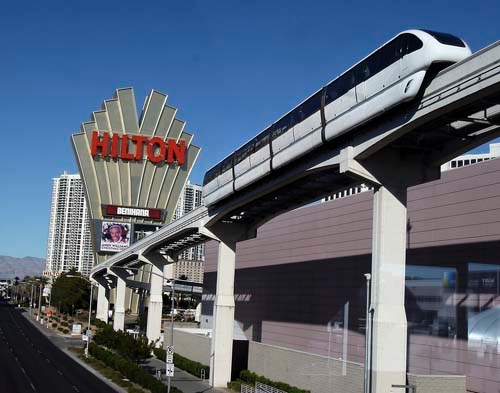DesertXpress feels like monorail redux

Consider these comments from two transportation leaders:
“It’s frustrating to see the people who won’t look at it with an open enough mind to see we really need a system like this.”
“If we don’t do this, if we shut this effort down, this community will very much regret having done that. They’ll look back and feel that we were very shortsighted.”
Could it be Senate Majority Leader Harry Reid and U.S. Secretary of Transportation Ray LaHood touting the steel-wheeled DesertXpress bullet train to Victorville, Calif.?
Nope. Those words were spoken more than a decade ago by the late Bob Broadbent, the mastermind behind the Las Vegas Monorail, and former Clark County Commissioner Bruce Woodbury, respectively. They were trying to muzzle critics barking about the $653 million in tax-exempt bonds the state was about to issue to build the monorail.
Both Broadbent and Woodbury were telling community members and skeptics that this was an opportunity of a lifetime. At the time, the monorail was not too much further along than the proposed DesertXpress is today.
Starting to see the connection? I hope so, because that is the only connection you will witness between either of these pricey trains.
Despite initial plans to loop the monorail through downtown and connect it to the airport, it remains a four-mile shuttle between select Strip resorts. The DesertXpress will terminate in Victorville, Calif., but plans call for an eventual connection to Palmdale, Calif., where it would link into the rest of California’s proposed high-speed network.
DesertXpress backers’ claims sound familiar: When it reaches Palmdale, the line will be a major success just like when the monorail reaches the airport, it too will be hugely popular. It’s important to point out that seven years have lapsed since the monorail’s first ride, and we’re about as close to connecting it to the airport as we are to starting construction on a high-speed train to, well, Victorville.
Will the similarities between the two transportation projects end at predictions and proclamations?
Supporters of the 150 mph DesertXpress and anyone who invests money into the line should hope so.
Who knows though. Like the backers of the monorail, DesertXpress representatives could make a ton of money off the project only to be long gone by the time the project proves to be a disaster.
But if you rewind a decade and look at the promises about the monorail, a skeptic can’t help but wonder if the pattern of unfulfilled projections might be repeated with the DesertXpress.
In 2000, Broadbent, who at the time was charged with selling the monorail to the public and, more importantly, the elected officials who held the purse strings, explained that at least 20 million passengers would hop on the Strip train every year at a cost of $2 per ride.
The closest the monorail ever came to that mark was in 2005, when, according to its own records, the Las Vegas Monorail hosted 10.3 million riders. I’m no mathematician, but that would be bad, very bad. Then the ridership figures worsened. Passenger counts dropped to 7 million in 2006, jumped back by about a million the next year and then steadily traveled downhill. In 2010, it hit an all-time low of 5.2 million passengers. By the way, it doesn’t cost $2 a ride, but $5.
The folks charged with overseeing the monorail are probably doing back flips over the Great Recession, because now they have a believable excuse for the poor showing.
Even if the economy brightens, the monorail’s picture likely will not.
Six years ago, federal officials essentially gave the system a vote of no-confidence, denying funding for an additional leg because it hadn’t come close to proving its financial viability. Last year, the monorail filed for bankruptcy protection. Then the Regional Transportation Commission refused to merge with the private monorail company, snuffing out any hope of federal assistance. In May, the Sahara hotel, the northern terminus of the monorail will close. If the Sahara’s parking garage is boarded up too, where would monorail passengers park?
Monorail cheerleaders claimed that the system was the only transit option that would succeed in removing both tourists and residents from their cars and thereby improving air quality in Las Vegas, which was constantly in violation of federal clean air standards.
The transportation commission came along a few years back with this double-decker called the Deuce and pretty much torpedoed the monorail supporters’ theory by spanking them in ridership numbers. In 2008, the buses carried 12 million passengers, in 2009, 11.5 million and last year 8.5 million riders. The 2010 ridership dipped, probably because of the introduction of the Express route which travels the Strip with fewer stops.
Obviously ridership numbers on the monorail are far short of overzealous projections. Could the DesertXpress meet the same fate? Are the high-speed train’s representatives truly going to believe that Las Vegans will spend $50 each way to Victorville, then rent a car and drive to Los Angeles?
Here is my prediction: No way. Right now if you book a late April round-trip ticket from Las Vegas to Long Beach, Calif. on Allegiant Airlines, you could do it for less than $30. Seriously.
The comments from DesertXpress fans sound familiar and, I’m afraid, so will the outcome.
If you have a question, tip or tirade, call Adrienne Packer at 702-387-2904, or send an e-mail to roadwarrior@reviewjournal
.com. Please include your phone number.